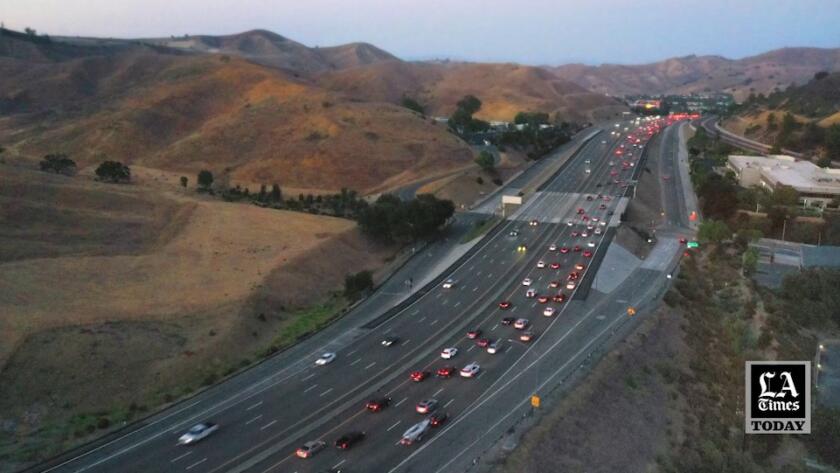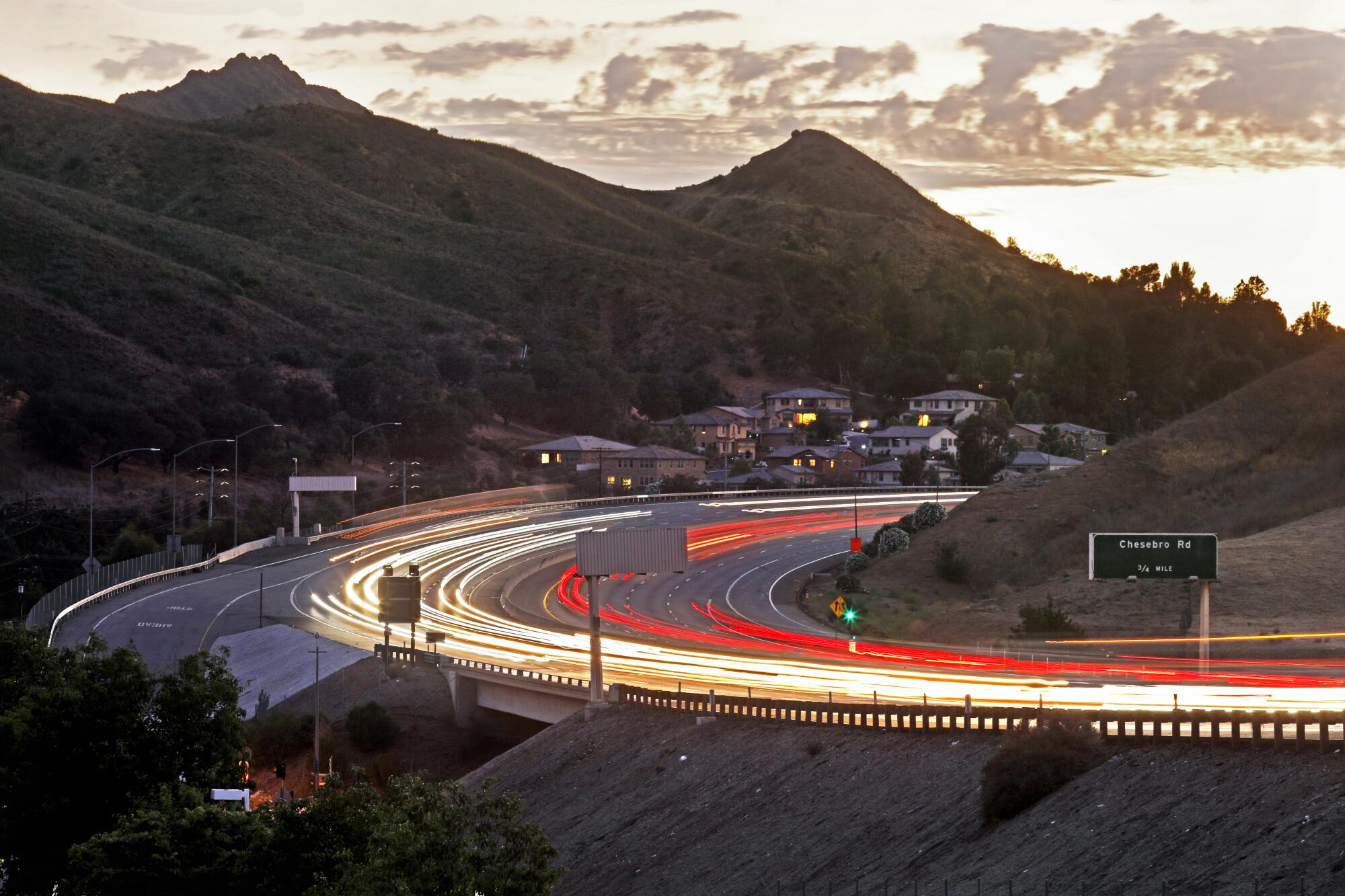
- Share via
Architect Robert Rock is facing a Herculean task: Design a bridge that will allow mountain lions to cross safely over a stretch of the 101 Freeway that roars with the traffic of 300,000 vehicles each day.
On a recent morning, he stood on a hilltop and gazed at a vista of steep fire-stripped slopes, rocky arroyos, weedy humps and 125-degree grade shifts on both sides of the freeway at Liberty Canyon in the city of Agoura Hills.
The terrain was as challenging as could be. But Rock could see the future — cougars who would otherwise become roadkill crossing a proposed $87-million bridge so that they could roam, find prey and mate.
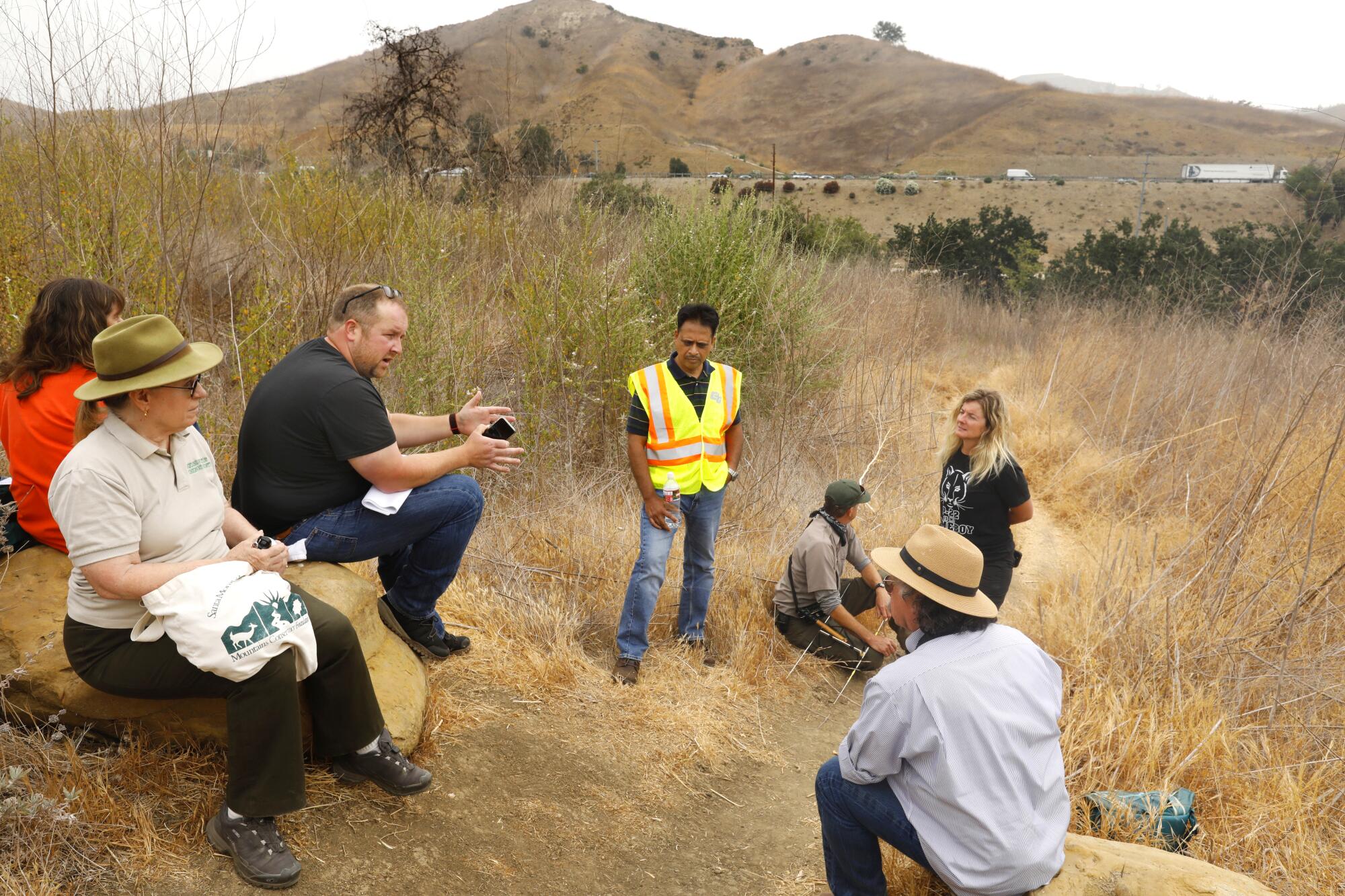
“Mountain lions are prone to wander,” said Rock, 40, raising his voice to be heard over the din of freeway traffic. “A wildlife crossing here is our best hope for keeping them from wandering into extinction.”
That’s a good metaphor for the new cooperative relationship between the urban and wild that a team of architects, federal biologists, conservation groups and government agencies want the proposed Wildlife Crossing at Liberty Canyon to symbolize.
The freeway was a product of the postwar boom in the 1940s and ’50s that gave rise to sprawl that separated much of Southern California from the natural world. It was a time when subdivisions spread ceaselessly, and the Los Angeles River was redefined as flood control infrastructure in the same category as electrical grids and freeway systems.
Future historians may look back on the wildlife crossing as a global model for conservation projects that champion the idea of coexistence with, not dominion over, nature.
When complete, the 200-foot-long, 165-foot-wide bridge will be the largest of its kind in the world.
In the last six years, interest in the proposal has grown and gained momentum — and so has its estimated cost.
The nonprofit National Wildlife Federation’s #SaveLACougars campaign must raise roughly $65 million by August to avoid costly delays and complete construction on schedule by 2025.
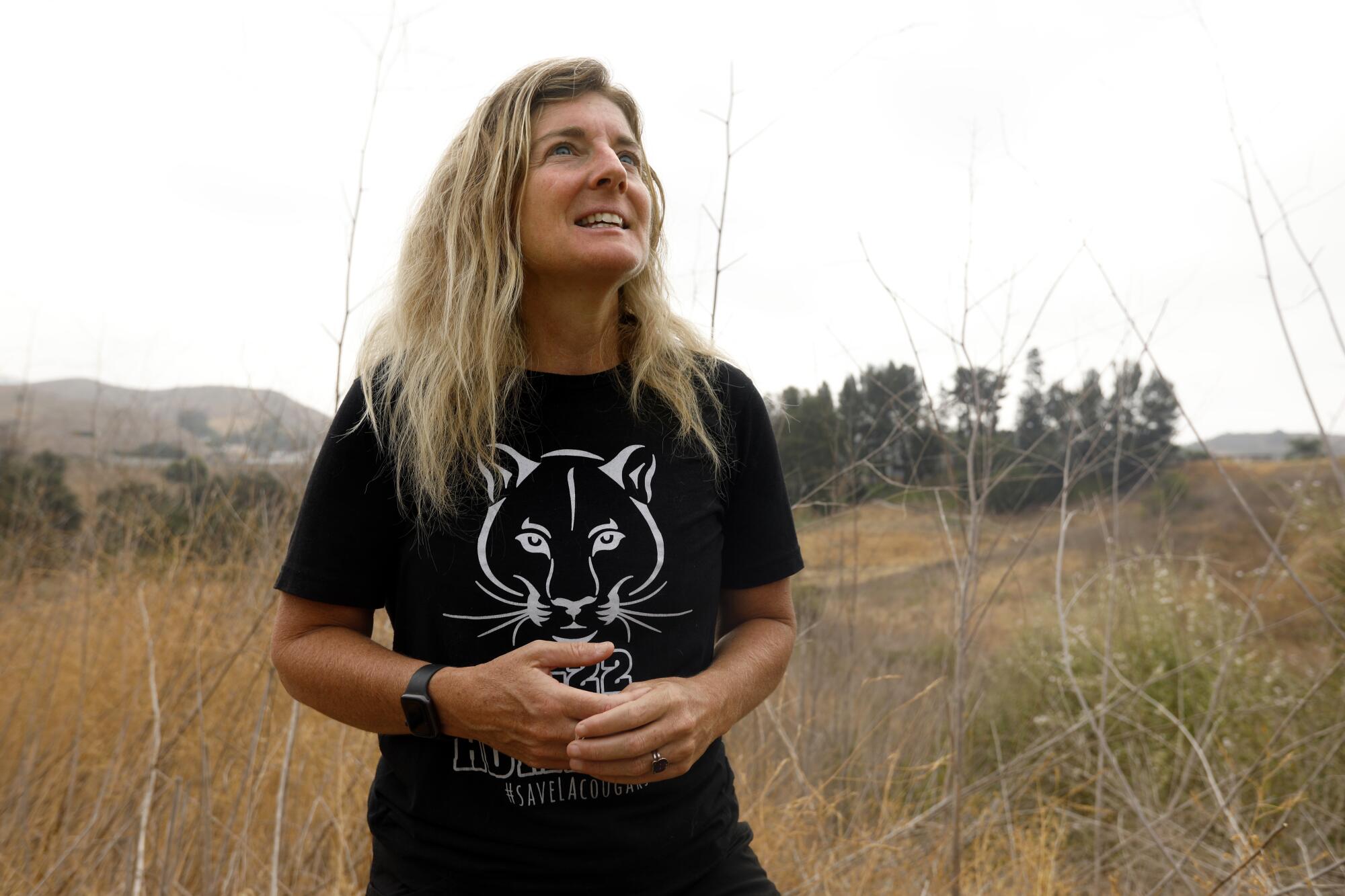
“We have secured $38 million for construction to date,” said Beth Pratt, regional executive director in California for the group. “This leaves about $27 million outstanding and is the amount we need to raise to break ground on time this fall.”
Scientists say the wildlife crossing is crucial to restoring gene flow among small, isolated populations of cougars trapped south of the freeway in the Santa Monica Mountains, and cougars confined to the north in the Simi Hills and Santa Susana Mountains.
Recent studies predict extinction probabilities of 16% to 28% over the next 50 years for these lions, which have the lowest genetic diversity documented for the species aside from the critically endangered Florida panther.
That’s partly because the 101 Freeway is a nearly impenetrable barrier to gene flow for the mountain lions, which biologists consider to be among the most threatened mammals in North America.
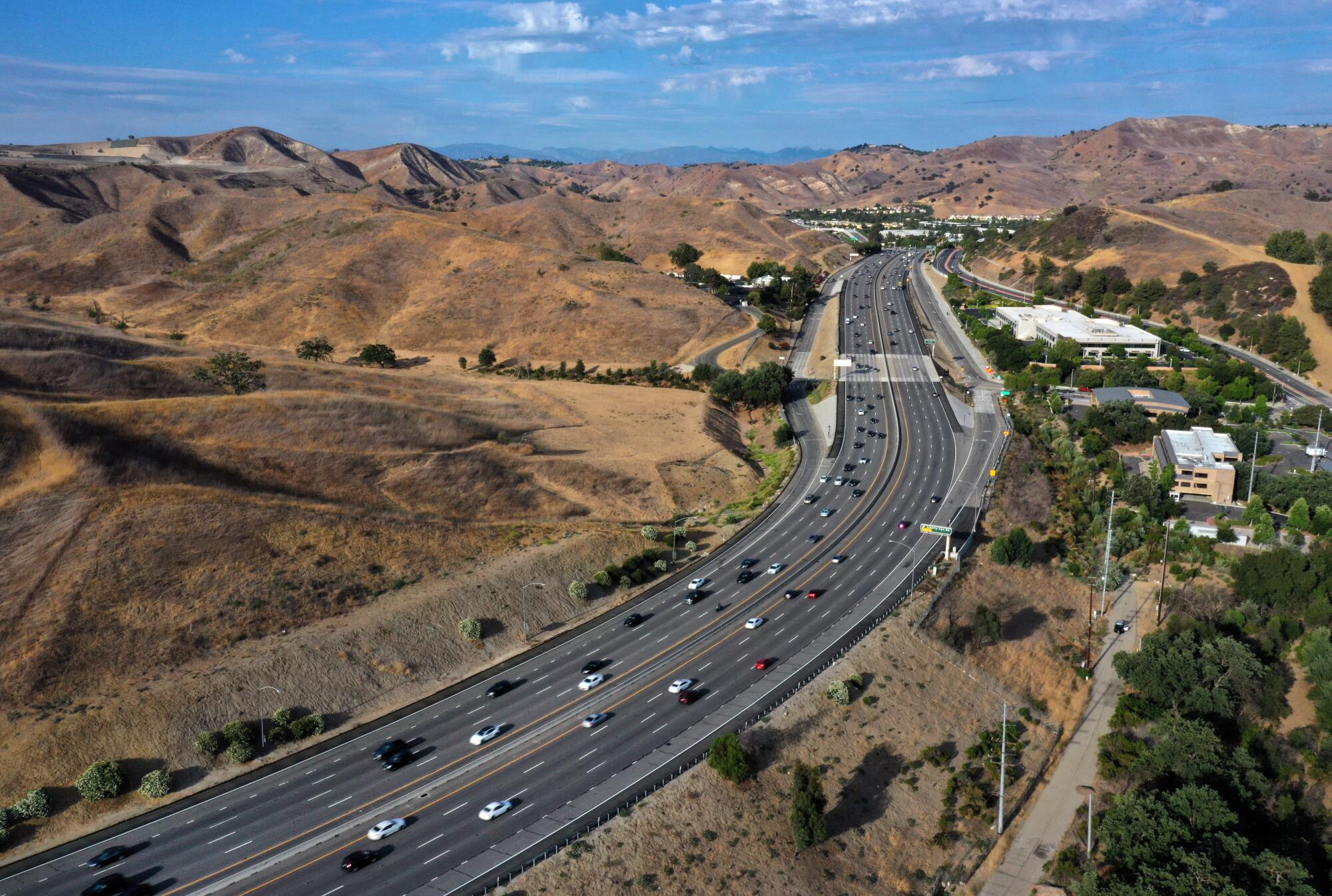
Brad Shaffer, an evolutionary biologist at UCLA, has high hopes the wildlife crossing will reshape not just the landscape for its top predator but the character of Southern California.
“From a biological perspective,” Shaffer said, “large top carnivores like mountain lions have beneficial cascading consequences on everything in the food chain — from mule deer to ground squirrels, lizards and insects.
“Beyond that, building a wildlife crossing to carry them over one of the busiest freeways in the nation sends a powerful message out to the world that Angelenos care about nature’s role in all of urban life,” he said.
Project partners include the California Department of Transportation, the National Park Service, the Santa Monica Mountains Conservancy, the Resource Conservation the National Park Service, the Santa Monica Mountains Conservancy, the Resource Conservation District of the Santa Monica Mountains, the National Wildlife Federation, and Rock, principal and chief operating officer of Living Habitats.
Because the bridge crosses the interstate, Caltrans will oversee design and construction — but the transportation agency is not providing funding. Instead, most of the funds come from over 3,000 private, philanthropic, and corporate donors around the world, including a recent $25-million challenge grant from Wallis Annenberg and the Annenberg Foundation.

“We can coexist, side by side, with wildlife and plant species,” Annenberg said, “instead of isolating and paving them over.”
As envisioned by Rock and Caltrans, cougars would move unseen by humans over a reinforced concrete and steel wildlife crossing landscaped with native vegetation including oak and willow trees, irrigation systems and shielded with sound walls and light deflectors to dampen the impacts of the noise and glare of headlights below.
Fencing up to 12 feet in height would funnel wildlife including mountain lions, bobcats, deer, coyote, skunks, badgers, squirrels, mice and lizards over the passage. To reduce roadkill, fencing would also extend several miles in both directions from the project footprint.
Another project challenge involves the development of “natural looking” abutments, approach slopes and walls that are expected to provide potential homes for small animals, birds and insects.
Safety netting will be installed to stop anything from dropping to the road.
In the meantime, Southern California is watching mountain lion populations decline steadily in the Santa Ana, San Gabriel, San Bernardino, Santa Monica, Santa Cruz and Tehachapi ranges.
Habitat fragmentation by urban development and highways, extremely low levels of genetic diversity, disease, territorial battles, rodenticide poisoning, vehicle collisions and human-caused wildfires are serious problems shared by lions in each of those ranges.

“The genetic diversity of our mountain lions is dangerously low,” said Jeff Sikich, a biologist with the Santa Monica Mountains National Recreational Area and an expert on local mountain lion populations. “Now, we’re starting to see physical evidence of it.”
Since 2020, he and other wildlife biologists have discovered three mountain lions in the Santa Monica range with the distortions of inbreeding — a tail kinked like the letter “L” and only one descended testicle.
The cougars represented the first documented physical manifestations of extremely low genetic diversity among the dozen mountain lions that roam 275 square miles in and around the Santa Monica Mountains National Recreation Area, which is bordered by the Pacific Ocean, the 405 and 101 freeways, housing and commercial developments, and agricultural fields.
Roadkill is also taking a toll. Since National Park Service biologists began researching mountain lions in the Santa Monicas in 2002, motorists have struck and killed at least 17 of the big cats in the study area, federal officials said.
Mountain lions as a species are not threatened in California. But a recent petition submitted to the state Fish and Game Commission by the Center for Biological Diversity and the nonprofit Mountain Lion Foundation argues that six isolated and genetically distinct cougar clans from Santa Cruz to the U.S.-Mexico border make up a subpopulation that should be listed as endangered.
A final determination by the commission is expected later this year.
In the meantime, the wildlife crossing team is focused on finalizing a design that balances the needs of cougars and motorist safety along the 101 Freeway — the major north-south route linking the Greater Los Angeles area, the Bay Area and the North Coast of California.
Rock specializes in commingling structural design and ecological performance. In 2017, his firm helped landscape the Obama Presidential Center on the South Side of Chicago. He is currently working on projects to reduce stormwater flooding in a historic Black community in Cook County, Ill., in addition to saving Los Angeles County’s cougars from extinction.
“Southern California has always been a place of novelty, innovation and inspiration,” he said. “In this case, that means creating a new type of scenic byway for wildlife over one of Southern California’s busiest freeways.”
- Share via
Watch L.A. Times Today at 7 p.m. on Spectrum News 1 on Channel 1 or live stream on the Spectrum News App. Palos Verdes Peninsula and Orange County viewers can watch on Cox Systems on channel 99.
